Ojai Was The “Journey’s End” For The Gorham Family
By David Mason
“Plans are completed and the contract let to A. Pefley for the construction of a unique and attractive foothills residence. H.M. Gorham, a banker of Santa Monica, will occupy the new villa, to be constructed entirely of cobble stones and moss-be-whiskered rocks, with tile and slate roof.”
-The Ojai, April 21, 1916
In a large formation of rocks piled high overlooking the East End of the Ojai Valley lies a silent giant.
Emerging from the earth and dominating the serene landscaping is a life-size stone whale. Its features are so detailed that it is hard to imagine that it is a sculpture done by Mother Nature during one of her more playful moods.
The area is a shady retreat with a freshwater stream that runs nearby. The early Indian population of this valley must have felt the reverence that prevailed in this area, for they would spend much time in the shadow of this great wonder.
Harry M. Gorham also must have felt the serenity when he first arrived in the Ojai. He was a man who could very well have afforded any other location in the world to build his home, but he chose the Ojai Valley.

Gorham was born in Cleveland, Ojai in 1859. He attended school there and was preparing to attend Harvard, but his plan did not materialize. Gorham’s uncle, John P. Jones, was a U.S. senator from Nevada, and he persuaded young Gorham to go to Virginia City to take a job in the Comstock silver mines, which Jones owned. The year was 1877.
The Comstock Lode would hold Gorham’s interest for 26 years, during which time he progressed up the ladder of success to superintendent of mines. He assumed a great deal of company responsibility because of the absence of his uncle, who was busy with the senatorial affairs and his vast real estate holdings in Santa Monica, Calif.
After a brief illness, Gorham left the mines and went to Southern California to join his uncle in his business ventures there. Gorham eventually became president of the Bank of Santa Monica.
Senator Jones’ daughter Marian developed great skills in tennis, winning the National Women’s Championship for two years. Gorham’s son Hal shared his cousin’s interest in the sport and in 1905 they both came to Ojai to compete in the interscholastic singles division of the Ojai Tennis Tournament. Harry Gorham, a widower, always attended the matches in which his son participated, and he became interested in the Ojai Valley during the tournament here.
Gorham met Mrs. Florence Rogers during one of his trips to the Ojai Valley. She was born in Cairo, Ill., and as a young lady, she had also been very active in the game of tennis. She attended Vassar at the age of 12 and achieved an outstanding scholastic record. She had met her first husband, Emery Rogers, a Harvard man, in Chicago, and after they were married they lived in Boston. Two children were born to them, a boy named Emery and a girl named Constance and called Connie. They were a very happy and proper family until Mr. Rogers died at a very young age of tuberculosis.
After the loss of her husband, Mrs. Rogers took an extensive trip to Europe. Her thoughts were that they would live in a different country each year and perhaps never come home.
As the children grew older, Mrs. Rogers became concerned that her son was falling under corruptive influences. She had this notion that he was going to get himself a mistress and steal off to live “la vie boheme” in some Paris garret. So she set about hunting down a stern, rigorous prep school to pack him off to.
Rogers cabled her mother and asked her to check into a school she had heard about that was in the small town of Nordhoff (now Ojai), called The Thacher School. After receiving the word back that the school was held in high regard, the Rogers family left Europe in 1907 on the first boat home.
Arriving in the Ojai Valley, the family found a small village with a post office and a few stories clustered together. The houses were scattered about the sagebrush-covered valley.
The family stayed at the Pierpont Cottages while waiting to get young Emery into Thacher. The school had a waiting list, but Mrs. Rogers was determined that her son would go there.
Since most of the people of the valley depended upon horses for transportation, she ordered an elaborate cart from Ireland for the family to use.
Shortly after she settled in the valley, she met Harry Gorham and they fell madly in love. They married a short time after their first meeting.
In 1908, the newlyweds built Casa de Paz on McAndrew Road, but when young Emery finished his schooling at Thacher, the Gorhams sold the house and moved to Santa Monica.
By 1916, with the purchase of the Whale Rock Ranch in the Ojai Valley, the Gorhams had decided to build a small stone cottage for a weekend retreat. They named it Journey’s End.
The house was built entirely of rock, hand-selected from the property. When finished, it commanded a view of the entire valley. It had one large room, with a fireplace that doubled as a source of heat and a means of cooking.
The beams for the house were put into place with the use of donkeys and ropes, under the supervision of Mrs. Gorham.
The extensive use of tile manufactured by the Gladding McBean Co. added color and character to the strong appearance of the stone. To quote the front-page headline of The Ojai: “New Modern Home to Beautify Valley.” That, indeed, was a true statement.
Young Emery Rogers joined the Army during World War I, and from his description of Major Carlyle H. Wash, his commanding officer, Mrs. Gorham decided that since the major was also a graduate of West Point, he might be the perfect gentleman for her daughter Connie. They were married in 1919.

The newlyweds moved with the military from base to base until 1921, when Wash was assigned as air attache to the American embassy in Paris, where they lived for three years. Carlyle Wash would continue his success in the Army, eventually becoming a general.
In 1932, when Mr. and Mrs. Gorham left Santa Monica to live at Journey’s End permanently, they added a small kitchen, bath and bedroom.
During World War II, General Wash was killed, along with his staff, in a plane crash during a storm. Connie and her young daughter Patsy returned to the Ojai Valley and to Journey’s End.
A second home was built on the property for Connie in 1948 by Ojai designer Austen Pierpont. It was built on the hillside with a balcony. The single-story home had a red tile roof and a sweeping view of the valley.
Connie Wash became quite active in events that were taking place in and around the valley. During the war, she was the tri-counties chairwoman of the Camp and Hospital Committee of the American Red Cross. She was also a hardworking member of the Ojai Chamber of Commerce and the East Ojai Valley Association. She spearheaded the movement to replace the street signs with the wooden signs that we now enjoy.
The Ojai Garden Club elected her president, and she helped to get the other members more involved in the city. She was a strong supporter of the Ojai Music Festival.
In 1969, another wing was added to the original Gorham house to make it larger. Through it all, the house retained its charm.
Today, the beautiful Journey’s End is an estate that has withstood all the elements, having been featured on the television show “20/20″ with the 1985 fire sweeping around it. The home has continued to be protected and loved by the same family.
In 1986, the county’s Cultural Heritage Board declared this property Ventura County Landmark No. 103, with the hope and desire that the Whale Rock and the romantic Journey’s End will remain for many future generations to come and enjoy.
As for the large whale, it still looms over the countryside and is now shaded by the many live oaks that cover the area. To all of the Ojai Valley, it remains a place held in high regard, deep respect, love and awe.
The above column originally appeared in the Ojai Valley News on Dec. 3, 1999. Republished with permission.

My husband and twin sister Jim & Louise McMasters would spend summers at Whale Rock Ranch with their uncle Charles Fletcher any info on the previous owner known around town as Chuck?
Thanks,
Dawn
In about 1973, I was employed by “Green’s Pest Control” that was located on Callens Road in Ventura. The company landed the job to fumigate Connie Wash’s beautiful tile-roofed home mentioned in this story. Of course, I and my fellow fumigation crew had to get up on the roof in order to cover the home with the large tarps used to hold in the fumigants. Doug Green, our boss, informed Mrs. Wash that it would be impossible to do the job without breaking a few of the thin and brittle roof tiles. We were instructed to walk in the small troughs made where the tiles overlap. We did so, but still damaged a number of tiles. Mr. Green had to special order tiles to replace the tiles we broke and had to pay for their installation too. I don’t know how he made any money on the job! This was the one and only time I ever got to go inside the home and to be able to walk around the grounds too. Quite a lovey home and an awestruck view of the Ojai Valley!
In about 1964-1965, I worked with Chuck Fletcher on a highway consruction survey crew at the State Division of Highways (now CalTrans). Chuck often talked about his home ranch Whale Rock but, even as a Valley native, I didn’t appreciate the history. Chuck shared citrus and avocadoes with his co-workers. I was born, at home, on Rice Road in Mira Monte in 1941. Went to Nordhoff schools through 8th grade. I think my late brother, David, was a friend of David Mason. My brother died last year (2014) in Holland.
My grandmother was the housekeeper for the Wash-Eaton household for many years. As a child, we would spend part of Christmas day in this fascinating house with these lovely, lovely people. The house was full of incredible treasures that, as a child, were simply magic. This article makes me wish I had asked more questions about the amazing history of these wonderful people.